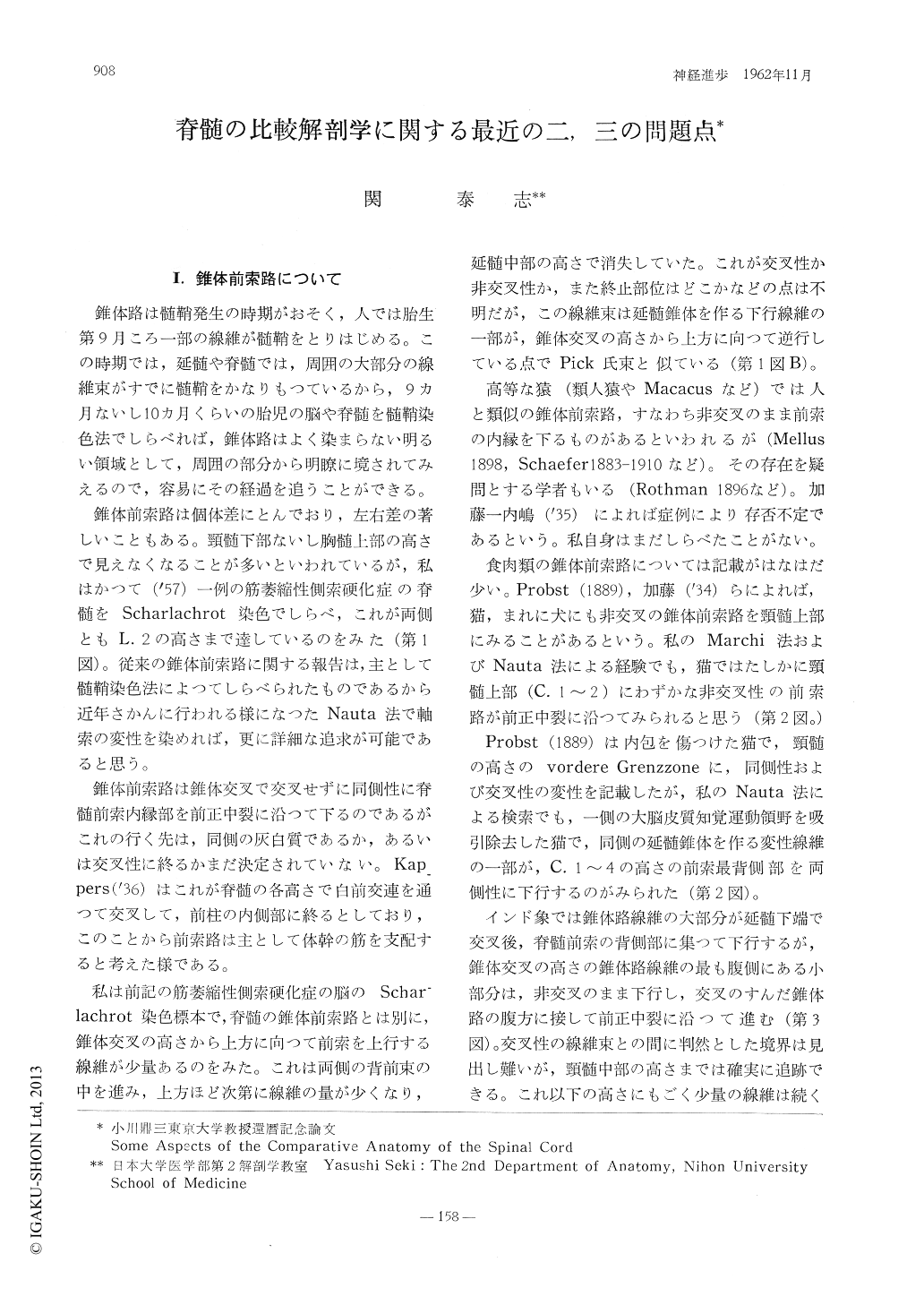Japanese
English
- 有料閲覧
- Abstract 文献概要
- 1ページ目 Look Inside
I.錐体前索路について
錐体路は髄鞘発生の時期がおそく,人では胎生第9月ころ一部の線維が髄鞘をとりはじめる。この時期では,延髄や脊髄では,周囲の大部分の線維束がすでに髄鞘をかなりもつているから,9カ月ないし10カ月くらいの胎児の脳や脊髄を髄鞘染色法でしらべれば,錐体路はよく染まらない明るい領域として,周囲の部分から明瞭に境されてみえるので,容易にその経過を追うことができる。
錐体前索路は個体差にとんでおり,左右差の著しいこともある。頸髄下部ないし胸髄上部の高さで見えなくなることが多いといわれているが,私はかつて(′57)一例の筋萎縮性側索硬化症の脊髄をScharlachrot染色でしらべ,これが両側ともL.2の高さまで達しているのをみた(第1図)。従来の錐体前索路に関する報告は,主として髄鞘染色法によつてしらべられたものであるから近年さかんに行われる様になつたNauta法で軸索の変性を染めれば,更に詳細な追求が可能であると思う。
1) The uncrossed anterior pyramidal tract was observed in the spinal cord of the man,indian elephant, mogera, calf and some cetaceas.
The degeneration of this tract was investi-gated bilaterally stained by scarlet red from the cerebral cortex down to the 2nd lumbal cord in a case of amyotrophic lateral sclerosis.
Though the pyramidal tract of the indian elephant was known as a crossed anterior funicular type, a small amount of uncrossed pyramidal fibers were observed also at the medial border of the anterior funiculus and they descend at the part closely ventral of the crossed pyramidal bundle until the middle cervical level.
In the mogera, calf, Lagenorhynchus obli-quidens, Lissodelphis borealis and Balaenop-tera borealis, the pyramidal decussation was hard:y recognized in the lowest level of the medulla oblongata, and the most fibers of the pyramidal bundle descend along the border of the anterior funiculus of the same side.
In the Eubalaena glacialis, the pyramids of both sides are fused into a wedge shaped bundle at the midline in the lower level of the medulla oblongata. More caudalward, the pyramid, decreasing the quantity of its fibers, changes into a spindle shaped tract and its location shifts slowly to dorsal and reaches then in the 1st cervical level. As all fibers of the pyramid are cut transversely in the transverse sections of this level, the pyramidal decussation was hardly recognized.
2) Nucleus cervicalis lateralis (NCL) is a cell group situated in the dorsal part of the lateral funiculus of the 1st and 2nd cervical cord. This nucleus was first r ported in detail in cats by Rexed and l3rodal (′51), and they considered it as a spino-cerebellar relay nucleus.
My experimental study showed that a clear degeneration bundle originating from this nucleus ascends in the spinal cord and the brain stem. This bundle d.-cussates at the anterior white commissure and shifts its position to the border of the anterior funicu-lus, then it ascends through the ventro-lateral part to the inferior olive and the late-ral part of the medial lemniscus, and termi-nates at the caudal part of the ventral nuc-leus of the optic thalamus. In addition, distinct retrograde degeneration was obser-ved in the NCL in cats being destroyed the lateral part of the contralateral medial lemnis-cue at the lower level of the midbrain, and the same effect was obtained in the cases damaged largely the most part of the ventral nucleus of the optic thalamus. From thesefindings, I think, it is [sure that the spino-thalamic tract of the cat originates from the NCL and terminates at the ventral nucleus of the contralateral optic thalamus.
The NCL was observed also in the dog, leopard, bear, weasel, marten (Japanese sa-ble), common seal, fur seal, sea lion, calf, horse, sheep, goat, wild boar, cammel and some cetaceas. On the contrary, in the man chimpanzee, orang utan, hylobates, ateles, rabbit, rat, mouse, squirrel, cangaroo, wara-bee and indian elephant, no distinct cell group was observed at the same position.
3) The nucleus dorsalis (Clarke's column) was examined in the spinal cord of the man cetacea and ateles with regard to its cell component and extent of the cell column along the long axis of the spinal cord.
Numerical analysis of the cells in this column of man revealed that there are three expansions and two shrinkages, but the cells of the Clarke's column type are recognized in the whole length of the spinal cord. The first expansion is seen at the upper levels of the cervical cord and represents the cervi-cal nucleus of Stilling, the second excess is located in the level from the lowermost part of the cervical to the upper part of the lum-bar cord and is corresponds to the nucleus dorsalis (Clarke's column), and the third is poor developed cell mass in the lower sacral levels and represents possibly the sacral nuc-leus of Stilling.
The Clarke's column of the Eubalaena is well developed in the thoraco-lumbal levels, and its maximum extent is found at the levels from lower thoracic to middle lumbal cord. Further-more, I found that the cell column extends directly to the lower lumbal and whole caudal levels, where a number of the cells of the same character are seen in the corresponding position of this levels.
The caudal extension of the Clarke's colu-mn is observed also in the spider monkey (ateles) ; many characteristic cells of the Clarke's column type are recognized in the whole length of the caudal cord. It deserves attention that both of cetaceas and ateles have very well developed tails or lower axial musculatures.
The nuclei of the dorsal funiculus contain a number of large, round cells, which lookquite the same type as the Clarke's column, and direct continuance to the cervical nuc-leus of Stilling was confirmed at the level of the pyramidal decussation.
The Clarke's column, the cervical and sac-ral nucleus of Stilling and the nuclei of the dorsal funiculus are continuous altogether, and they make a long cell column of the same histological structures.
4) Macroscopical and microscopical obser-vations of the spinal cord of a female Euba-laena glacialis revealed some remarkable structures.
The length of the spinal cord is very short as compared with the body length (14.9%). The cauda equina is not present inside the dura mater, but exists only in the epidural space, where are also extremely rich blood vessels and fatty tissue. Externally, the lumbal enlargement is not distinct, but it is clearly demonstrated by the curve indicating the dimension of the gray substance in the cross section of each level and it extends in maximum at the caudal level.
The anterior column of the cervical enlar-gement is very well developed in the trans-verse direction, but in the lumbal enlarge-ment, it is elongated rather in the ventro-dor-sal direction. These shapes are due perhaps to the lacks of the lateral part of the anterior column in the lumbal enlargement, in which the cells innervate the musculature of the lower extremities.
The posteoior column is less developed in the almost all levels than the anterior colu-mn, but only in C. 1 it is moderately large. The largeness in C. 1 is caused probably by the lower extension of the spinal roots and these nuclei of the trigeminal nerve, which are well developed in the medulla oblongata. Fusion of the posterior column of both sides is observed in the lower thoracic and the caudal levels.
The central canal is fully obliterated through the whole length of the spinal crod.
The spinal roots of the accessory nerve are very poorly developed, and only arised in the 1st cervical level.
The lower extension of the nucleus ambi-guus is directly continuous to the lateral part of the anterior column in the 1st cervical cord.

Copyright © 1962, Igaku-Shoin Ltd. All rights reserved.


